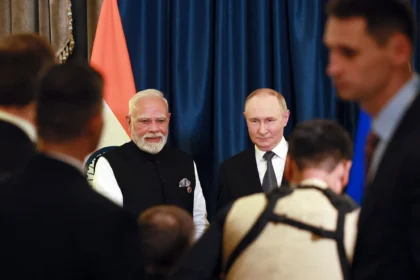Urgent Alert: Remaining 2 S-400 Defence Systems to Arrive On Time, Russian Envoy Confirms Amid Escalating India-Pakistan Tensions
Remaining S-400 Defence Systems to Arrive On Time, Russian Envoy Confirms Amid Escalating India-Pakistan Tensions, Strategic Security Boost, Crucial Defence Update
Russian Deputy Ambassador to India, Roman Babushkin, confirmed on Monday that India will receive the remaining regiments of the S-400 Triumf strategic air defence missile system as per the original schedule by 2026. The announcement comes amid heightened India-Pakistan tensions and follows reports highlighting the effectiveness of the S-400 system during India’s recent Operation Sindoor against Pakistan.
India’s deployment of the S-400 air defence system has been a critical milestone in bolstering the nation’s aerial defence capabilities. During Operation Sindoor, the system played a pivotal role by successfully intercepting Pakistani drones and missile threats, demonstrating its operational effectiveness under real combat conditions. Babushkin acknowledged these achievements while addressing the media, stating, “We heard that the S-400 performed very efficiently during the situation between India and Pakistan.”
India’s acquisition of the S-400 missile system, commonly referred to domestically as the “Sudarshan Chakra,” represents one of the most significant defence procurements in recent years. Signed in 2018, the contract with Russia is valued at approximately $5.43 billion and includes the delivery of five regiments. So far, three regiments have been deployed strategically along India’s western and northern borders, which face Pakistan and China respectively, two countries with whom India maintains complex and often tense security dynamics.
Babushkin emphasized the strong historical defence cooperation between India and Russia, describing the partnership as “one of the promising topics of our partnership in defence preparation in general.” He further elaborated on the ongoing collaboration and hinted at the possibility of expanding dialogue regarding additional air defence systems, signaling continued deepening of strategic ties between the two countries. “As far as my knowledge goes, the contract for the remaining S-400 units will be according to the schedule. We are open for a promotion of this partnership for the discussion of the expansion of dialogue on air defence system… I think it will be done in 2025, 2026,” he added.
India’s phased receipt of the S-400 regiments began in December 2021 with the delivery of the first regiment, followed by the second in April 2022 and the third in October 2023. Originally, the contract envisaged completion by 2023. However, the Russia-Ukraine conflict disrupted global supply chains and production timelines, resulting in delays in the delivery schedule. Despite these challenges, both nations remain committed to fulfilling the contract within the next few years.
The S-400 missile system is highly regarded globally for its advanced technological capabilities. It features a detection range of up to 380 kilometers and is designed to detect and destroy hostile targets including strategic bombers, fighter jets, spy planes, missiles, and drones. This system can simultaneously engage multiple aerial targets across varying altitudes and distances, providing a formidable shield against aerial threats.
The system comprises three core components: missile launchers, a powerful radar system, and a central command and control center. Its ability to target a diverse array of threats—from aircraft and cruise missiles to high-speed intermediate-range ballistic missiles—makes it a versatile and potent asset in India’s air defence arsenal.
India’s Ministry of Defence has highlighted the significance of the S-400 acquisition in enhancing the nation’s defence posture. A 2021 ministry statement described the system as “a potent system in terms of its operational capability to provide a continuous and effective air defence system to a very large area.” The statement further added, “With the induction of this system, air defence capability of the nation will be significantly enhanced.”

Globally, the S-400 is considered a game-changer in air defence technology. It is viewed by NATO members as a major strategic threat due to its long-range interception capabilities and adaptability against nearly all types of modern combat aircraft. Its deployment has prompted several geopolitical conversations, especially as countries seek to balance defence readiness with evolving regional security challenges.
The successful integration and deployment of the S-400 system also serve as a critical deterrent against hostile actions in India’s volatile neighborhood, particularly along its western border with Pakistan. Given the recent escalation in cross-border tensions, the enhanced air defence capability offered by the S-400 system contributes significantly to India’s defensive and retaliatory options.
Looking ahead, the completion of the remaining deliveries by 2026 will further strengthen India’s layered defence architecture, positioning the country to better manage and neutralize evolving aerial threats. The continued defence partnership between India and Russia underscores their mutual strategic interests and India’s commitment to maintaining technological superiority in its defence forces.
In conclusion, the Russian envoy’s confirmation about the timely arrival of the remaining S-400 regiments highlights a crucial development in India’s defence preparedness. Coupled with its proven operational effectiveness during recent conflicts, the S-400 system remains a cornerstone in India’s efforts to safeguard its airspace amid complex regional security dynamics. The strategic collaboration between India and Russia continues to be a key pillar in ensuring India’s long-term defence capabilities and regional stability.
Also Read : Kamal Haasan Urgently Moves Karnataka HC After KFCC Shocks Industry by Banning ‘Thug Life’ Release








